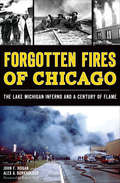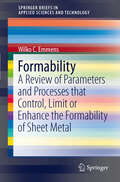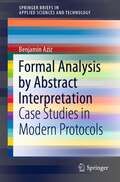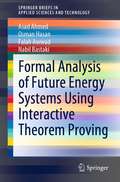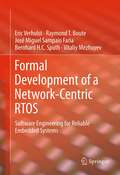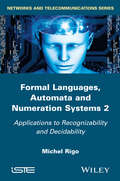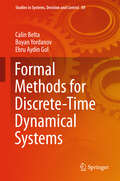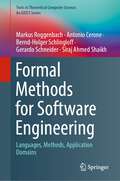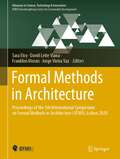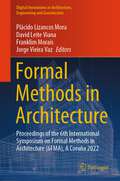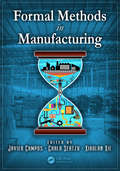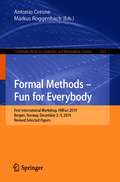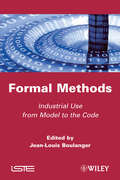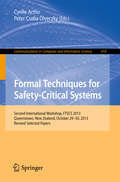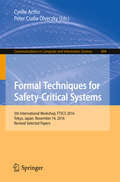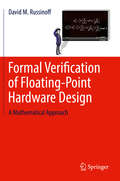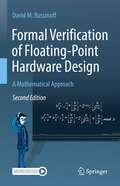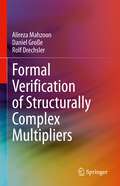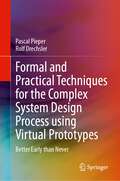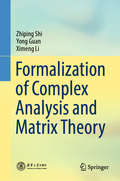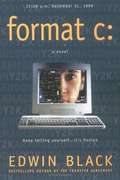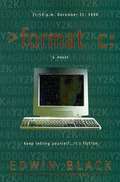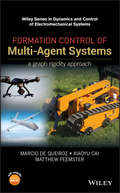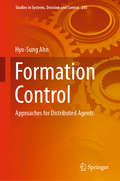- Table View
- List View
Forgotten Fires of Chicago: The Lake Michigan Inferno and a Century of Flame (Disaster Ser.)
by John F. Hogan Alex A. BurkholderA historical journey through the city&’s catastrophic fires, and the stories of the heroes who fought them. Chicago&’s war against cinder, flame, and smoke did not end with the Great Fire of 1871. In 1909, fire ripped through the dynamite room of a staging facility a mile and half off the Lake Michigan shoreline, transforming the pipe-laying operation into a raging inferno. During the World&’s Columbian Exposition, thousands of fairgoers watched in horror as twelve firefighters were trapped in a blazing ice warehouse. An opera-goer left a smoking bomb under his seat at the Auditorium Theater in 1917. And the newly invented smoke ejector arrived too late to save firemen and laborers cut off in a sewer in 1931. Join John F. Hogan and Alex A. Burkholder for the history of these forgotten fires—and those who responded to them. &“A must-read not only for first responders but also all history buffs, especially those interested in Chicago history.&” —Robert Hoff, retired fire commissioner, Chicago Fire Department, from the foreword
Formability
by Wilko C. Emmens- Overview of materials and treatment aspects of manufacturability of sheet metal - Written by an industrial expert turned scientist - Concentrates on the formability of sheet metal, one of the fundamental form material is used in metalworking
Formal Analysis by Abstract Interpretation: Case Studies in Modern Protocols (SpringerBriefs in Applied Sciences and Technology)
by Benjamin AzizThe book provides a gentle introduction and definition of the denotational-based abstract interpretation method. The book demonstrates how the above method of formal analysis can be used, not only to address the security of systems, but other more general and interesting properties related to the testing, mutating and semantic ambiguity resolution of protocols. The book presents three case studies, all related to current complex protocols and standards used in industry, particularly in the context of IoT and Industry 4.0.
Formal Analysis of Future Energy Systems Using Interactive Theorem Proving (SpringerBriefs in Applied Sciences and Technology)
by Osman Hasan Asad Ahmed Falah Awwad Nabil BastakiThis book describes an accurate analysis technique for energy systems based on formal methods—computer-based mathematical logic techniques for the specification, validation, and verification of the systems. Correctness and accuracy of the financial, operational, and implementation analysis are of the paramount importance for the materialization of the future energy systems, such as smart grids, to achieve the objectives of cost-effectiveness, efficiency, and quality-of-service. In this regard, the book develops formal theories of microeconomics, asymptotic, and stability to support the formal analysis of generation and distribution cost, smart operations, and processing of energy in a smart grid. These formal theories are also employed to formally verify the cost and utility modeling for: Energy generation and distribution;Asymptotic bounds for online scheduling algorithms for plug-in electric vehicles; andStability of the power converters for wind turbines. The proposed approach results in mechanized proofs for the specification, validation, and verification of corresponding smart grid problems. The formal mathematical theories developed can be applied to the formal analysis of several other hardware and software systems as well, making this book of interest to researchers and practicing engineers in a variety of power electronic fields.
Formal Development of a Network-Centric RTOS
by Eric Verhulst José Miguel Faria Raymond T. Boute Vitaliy Mezhuyev Bernhard H.C. SputhMany systems, devices and appliances used routinely in everyday life, ranging from cell phones to cars, contain significant amounts of software that is not directly visible to the user and is therefore called "embedded". For coordinating the various software components and allowing them to communicate with each other, support software is needed, called an operating system (OS). Because embedded software must function in real time (RT), a RTOS is needed. This book describes a formally developed, network-centric Real-Time Operating System, OpenComRTOS. One of the first in its kind, OpenComRTOS was originally developed to verify the usefulness of formal methods in the context of embedded software engineering. Using the formal methods described in this book produces results that are more reliable while delivering higher performance. The result is a unique real-time concurrent programming system that supports heterogeneous systems with just 5 Kbytes/node. It is compatible with safety related engineering standards, such as IEC61508.
Formal Languages, Automata and Numeration Systems, Volume 2
by Michel RigoThe interplay between words, computability, algebra and arithmetic has now proved its relevance and fruitfulness. Indeed, the cross-fertilization between formal logic and finite automata (such as that initiated by J.R. Büchi) or between combinatorics on words and number theory has paved the way to recent dramatic developments, for example, the transcendence results for the real numbers having a "simple" binary expansion, by B. Adamczewski and Y. Bugeaud. This book is at the heart of this interplay through a unified exposition. Objects are considered with a perspective that comes both from theoretical computer science and mathematics. Theoretical computer science offers here topics such as decision problems and recognizability issues, whereas mathematics offers concepts such as discrete dynamical systems.The main goal is to give a quick access, for students and researchers in mathematics or computer science, to actual research topics at the intersection between automata and formal language theory, number theory and combinatorics on words. The second of two volumes on this subject, this book covers regular languages, numeration systems, formal methods applied to decidability issues about infinite words and sets of numbers.
Formal Methods for Discrete-Time Dynamical Systems
by Calin Belta Boyan Yordanov Ebru Aydin GolThis book bridges fundamental gaps between control theory and formal methods. Although it focuses on discrete-time linear and piecewise affine systems, it also provides general frameworks for abstraction, analysis, and control of more general models. The book is self-contained, and while some mathematical knowledge is necessary, readers are not expected to have a background in formal methods or control theory. It rigorously defines concepts from formal methods, such as transition systems, temporal logics, model checking and synthesis. It then links these to the infinite state dynamical systems through abstractions that are intuitive and only require basic convex-analysis and control-theory terminology, which is provided in the appendix. Several examples and illustrations help readers understand and visualize the concepts introduced throughout the book.
Formal Methods for Software Engineering: Languages, Methods, Application Domains (Texts in Theoretical Computer Science. An EATCS Series)
by Antonio Cerone Siraj Ahmed Shaikh Markus Roggenbach Gerardo Schneider Bernd-Holger SchlingloffSoftware programs are formal entities with precise meanings independent of their programmers, so the transition from ideas to programs necessarily involves a formalisation at some point. The first part of this graduate-level introduction to formal methods develops an understanding of what constitutes formal methods and what their place is in Software Engineering. It also introduces logics as languages to describe reasoning and the process algebra CSP as a language to represent behaviours. The second part offers specification and testing methods for formal development of software, based on the modelling languages CASL and UML. The third part takes the reader into the application domains of normative documents, human machine interfaces, and security. Use of notations and formalisms is uniform throughout the book. Topics and features: Explains foundations, and introduces specification, verification, and testing methods Explores various application domains Presents realistic and practical examples, illustrating concepts Brings together contributions from highly experienced educators and researchers Offers modelling and analysis methods for formal development of software Suitable for graduate and undergraduate courses in software engineering, this uniquely practical textbook will also be of value to students in informatics, as well as to scientists and practical engineers, who want to learn about or work more effectively with formal theories and methods. Markus Roggenbach is a Professor in the Dept. of Computer Science of Swansea University. Antonio Cerone is an Associate Professor in the Dept. of Computer Science of Nazarbayev University, Nur-Sultan. Bernd-Holger Schlingloff is a Professor in the Institut für Informatik of Humboldt-Universität zu Berlin. Gerardo Schneider is a Professor in the Dept. of Computer Science and Engineering of University of Gothenburg. Siraj Ahmed Shaikh is a Professor in the Institute for Future Transport and Cities of Coventry University.
Formal Methods in Architecture: Proceedings of the 5th International Symposium on Formal Methods in Architecture (5FMA), Lisbon 2020 (Advances in Science, Technology & Innovation)
by Sara Eloy David Leite Viana Franklim Morais Jorge Vieira VazThis edited book gathers research studies presented at the 5th International Symposium on Formal Methods in Architecture (5FMA), Lisbon 2020. Studies focus on the use of methodologies, especially those that have witnessed recent developments, that stem from the mathematical and computer sciences and are developed in a collaborative way with architecture and related fields. This book constitutes a contribution to the debate and to the introduction of new methodologies and tools in the mentioned fields that derive from the application of formal methods in the creation of new explicit languages for problem-solving in architecture and urbanism. It adds valuable insight into the development of new practices solving identified societal problems and promoting the digital transformation of institutions in the mentioned fields. The primary audience of this book will be from the fields of architecture, urban planning, civil engineering, AEC, landscape design, computer sciences and mathematics, both academicians and professionals.
Formal Methods in Architecture: Proceedings of the 6th International Symposium on Formal Methods in Architecture (6FMA), A Coruña 2022 (Digital Innovations in Architecture, Engineering and Construction)
by David Leite Viana Franklim Morais Jorge Vieira Vaz Plácido Lizancos MoraThis book comprises the select proceedings of the 6th International Symposium on Formal Methods in Architecture (6FMA), A Coruña 2022. The contents focus on the use of methodologies, especially those that have witnessed recent developments stemming from mathematical and computer sciences and are developed in a collaborative way with architecture and related fields. This book constitutes a contribution to the debate and to the introduction of new methodologies and tools in the mentioned fields that derive from the application of formal methods in the creation of new explicit languages for problem-solving in architecture and urbanism. Some of the themes in the book are CAD and BIM, mixed realities, photogrammetry and 3D scan, architectural design automation, urban and building performance analysis, SCAVA-space configuration, accessibility and visibility analysis. This book proves a valuable resource for those in academia and industry.
Formal Methods in Manufacturing (Industrial Information Technology)
by Javier Campos Xiaolan Xie Carla SeatzuIllustrated with real-life manufacturing examples, Formal Methods in Manufacturing provides state-of-the-art solutions to common problems in manufacturing systems. Assuming some knowledge of discrete event systems theory, the book first delivers a detailed introduction to the most important formalisms used for the modeling, analysis, and control of manufacturing systems (including Petri nets, automata, and max-plus algebra), explaining the advantages of each formal method. It then employs the different formalisms to solve specific problems taken from today’s industrial world, such as modeling and simulation, supervisory control (including deadlock prevention) in a distributed and/or decentralized environment, performance evaluation (including scheduling and optimization), fault diagnosis and diagnosability analysis, and reconfiguration. Containing chapters written by leading experts in their respective fields, Formal Methods in Manufacturing helps researchers and application engineers handle fundamental principles and deal with typical quality goals in the design and operation of manufacturing systems.
Formal Methods – Fun for Everybody: First International Workshop, FMFun 2019, Bergen, Norway, December 2–3, 2019, Revised Selected Papers (Communications in Computer and Information Science #1301)
by Antonio Cerone Markus RoggenbachThis volume constitutes the post-workshop proceedings of the First International Workshop on Formal Methods – Fun for Everybody, FMFun 2019, held in Bergen, Norway, in December 2019.The 7 revised full papers and 2 revised short papers presented in this volume were carefully reviewed and selected from 15 submissions. A white paper and two keynote papers are also included. The papers explore ways of utilizing the pathway to transforming and spreading formal methods. The vision of this workshop series is that formal methods ought to be taught in such a way that every student can have fun with it.
Formal Methods: Industrial Use from Model to the Code (Wiley-iste Ser. #692)
by Jean-Louis BoulangerAlthough formal analysis programming techniques may be quite old, the introduction of formal methods only dates from the 1980s. These techniques enable us to analyze the behavior of a software application, described in a programming language. It took until the end of the 1990s before formal methods or the B method could be implemented in industrial applications or be usable in an industrial setting. Current literature only gives students and researchers very general overviews of formal methods. The purpose of this book is to present feedback from experience on the use of “formal methods” (such as proof and model-checking) in industrial examples within the transportation domain. This book is based on the experience of people who are currently involved in the creation and evaluation of safety critical system software. The involvement of people from within the industry allows us to avoid the usual problems of confidentiality which could arise and thus enables us to supply new useful information (photos, architecture plans, real examples, etc.). Topics covered by the chapters of this book include SAET-METEOR, the B method and B tools, model-based design using Simulink, the Simulink design verifier proof tool, the implementation and applications of SCADE (Safety Critical Application Development Environment), GATeL: A V&V Platform for SCADE models and ControlBuild. Contents 1. From Classic Languages to Formal Methods, Jean-Louis Boulanger. 2. Formal Method in the Railway Sector the First Complex Application: SAET-METEOR, Jean-Louis Boulanger. 3. The B Method and B Tools, Jean-Louis Boulanger. 4. Model-Based Design Using Simulink – Modeling, Code Generation, Verification, and Validation, Mirko Conrad and Pieter J. Mosterman. 5. Proving Global Properties with the Aid of the SIMULINK DESIGN VERIFIER Proof Tool, Véronique Delebarre and Jean-Frédéric Etienne. 6. SCADE: Implementation and Applications, Jean-Louis Camus. 7. GATeL: A V&V Platform for SCADE Models, Bruno Marre, Benjamin Bianc, Patricia Mouy and Christophe Junke. 8. ControlBuild, a Development Framework for Control Engineering, Franck Corbier. 9. Conclusion, Jean-Louis Boulanger.
Formal Techniques for Safety-Critical Systems
by Cyrille Artho Peter Csaba ÖlveczkyThis book constitutes the refereed proceedings of the 4th International Workshop on Formal Techniques for Safety-Critical Systems, FTSCS 2015, held in Paris, France, in November 2015. The 15 revised full papers presented together with one invited talk and two tool papers were carefully reviewed and selected from 41 submissions. The papers are organized in topical sections on timed systems; railway systems; fault tolerance; automotive systems; software and systems analysis; tools.
Formal Techniques for Safety-Critical Systems
by Cyrille Artho Peter Csaba ÖlveczkyThis book constitutes the refereed proceedings of the Second International Workshop, FTSCS 2013, held in Queenstown, New Zealand, in October 2013. The 17 revised full papers presented together with an invited talk were carefully reviewed and selected from 32 submissions. The papers address various topics related to the application of formal and semi-formal methods to improve the quality of safety-critical computer systems.
Formal Verification of Floating-Point Hardware Design: A Mathematical Approach
by David M. Russinoff J Strother MooreThis is the first book to focus on the problem of ensuring the correctness of floating-point hardware designs through mathematical methods. Formal Verification of Floating-Point Hardware Design advances a verification methodology based on a unified theory of register-transfer logic and floating-point arithmetic that has been developed and applied to the formal verification of commercial floating-point units over the course of more than two decades, during which the author was employed by several major microprocessor design companies. The book consists of five parts, the first two of which present a rigorous exposition of the general theory based on the first principles of arithmetic. Part I covers bit vectors and the bit manipulation primitives, integer and fixed-point encodings, and bit-wise logical operations. Part II addresses the properties of floating-point numbers, the formats in which they are encoded as bit vectors, and the various modes of floating-point rounding. In Part III, the theory is extended to the analysis of several algorithms and optimization techniques that are commonly used in commercial implementations of elementary arithmetic operations. As a basis for the formal verification of such implementations, Part IV contains high-level specifications of correctness of the basic arithmetic instructions of several major industry-standard floating-point architectures, including all details pertaining to the handling of exceptional conditions. Part V illustrates the methodology, applying the preceding theory to the comprehensive verification of a state-of-the-art commercial floating-point unit. All of these results have been formalized in the logic of the ACL2 theorem prover and mechanically checked to ensure their correctness. They are presented here, however, in simple conventional mathematical notation. The book presupposes no familiarity with ACL2, logic design, or any mathematics beyond basic high school algebra. It will be of interest to verification engineers as well as arithmetic circuit designers who appreciate the value of a rigorous approach to their art, and is suitable as a graduate text in computer arithmetic.
Formal Verification of Floating-Point Hardware Design: A Mathematical Approach
by David M. RussinoffThis is the first book to focus on the problem of ensuring the correctness of floating-point hardware designs through mathematical methods. Formal Verification of Floating-Point Hardware Design, Second Edition advances a verification methodology based on a unified theory of register-transfer logic and floating-point arithmetic that has been developed and applied to the formal verification of commercial floating-point units over the course of more than two decades, during which the author was employed by several major microprocessor design companies. The theory is extended to the analysis of several algorithms and optimization techniques that are commonly used in commercial implementations of elementary arithmetic operations. As a basis for the formal verification of such implementations, high-level specifications of the basic arithmetic instructions of several major industry-standard floating-point architectures are presented, including all details pertaining to the handling of exceptional conditions. The methodology is illustrated in the comprehensive verification of a variety of state-of-the-art commercial floating-point designs developed by Arm Holdings. This revised edition reflects the evolving microarchitectures and increasing sophistication of Arm processors, and the variation in the design goals of execution speed, hardware area requirements, and power consumption. Many new results have been added to Parts I—III (Register-Transfer Logic, Floating-Point Arithmetic, and Implementation of Elementary Operations), extending the theory and describing new techniques. These were derived as required in the verification of the new RTL designs described in Part V.
Formal Verification of Structurally Complex Multipliers
by Rolf Drechsler Daniel Große Alireza MahzoonThis book addresses the challenging tasks of verifying and debugging structurally complex multipliers. In the area of verification, the authors first investigate the challenges of Symbolic Computer Algebra (SCA)-based verification, when it comes to proving the correctness of multipliers. They then describe three techniques to improve and extend SCA: vanishing monomials removal, reverse engineering, and dynamic backward rewriting. This enables readers to verify a wide variety of multipliers, including highly complex and optimized industrial benchmarks. The authors also describe a complete debugging flow, including bug localization and fixing, to find the location of bugs in structurally complex multipliers and make corrections.
Formal and Practical Techniques for the Complex System Design Process using Virtual Prototypes: Better Early than Never
by Rolf Drechsler Pascal PieperThis book deals with formal and practical approaches for early fast modeling and verification of complex digital processor hardware and software using SystemC-based virtual prototypes. As a special focus, modeling approaches of instruction-level behavior of System-on-Chips and the connected off-chip digital devices are addressed. Featured verification approaches are based on symbolic execution of simulated hardware devices or on classical discrete execution of the whole system with dynamic data flow tracking. The approaches are accompanied by Case-Studies that develop and build on top of an open-source RISC-V SoC simulation.In Particular, this book:
Formalization of Complex Analysis and Matrix Theory
by Yong Guan Zhiping Shi Ximeng LiThis book discusses the formalization of mathematical theories centering on complex analysis and matrix theory, covering topics such as algebraic systems, complex numbers, gauge integration, the Fourier transformation and its discrete counterpart, matrices and their transformation, inner product spaces, and function matrices. The formalization is performed using the interactive theorem prover HOL4, chiefly developed at the University of Cambridge. Many of the developments presented are now integral parts of the library of this prover.As mathematical developments continue to gain in complexity, sometimes demanding proofs of enormous sizes, formalization has proven to be invaluable in terms of obtaining real confidence in their correctness. This book provides a basis for the computer-aided verification of engineering systems constructed using the principles of complex analysis and matrix theory, as well as building blocks for the formalization of more involved mathematical theories.
Format C:
by Edwin BlackTwo Millennial fears haunted most Americans at the tunr of the last century: the sense of Armageddon, and the pending Y2K crisis. Both are woven together in Edwin Black's Format C:, a tense and compelling mystic techno-thriller about the final battle between good and evil fought against the race to fix the Millennium Bug.
Format C:
by Edwin BlackBlack weaves together two millennial fears--the sense of Armageddon, and the impending Y2K crisis--into a tense and compelling, mystic techno-thriller about the final battle between good and evil fought during the race to fix the Millennium Bug.
Formation Control of Multi-Agent Systems: A Graph Rigidity Approach (Wiley Series in Dynamics and Control of Electromechanical Systems)
by Marcio De Queiroz Xiaoyu Cai Matthew FeemsterFormation Control of Multi-Agent Systems: A Graph Rigidity Approach Marcio de Queiroz, Louisiana State University, USA Xiaoyu Cai, FARO Technologies, USA Matthew Feemster, U.S. Naval Academy, USA A comprehensive guide to formation control of multi-agent systems using rigid graph theory This book is the first to provide a comprehensive and unified treatment of the subject of graph rigidity-based formation control of multi-agent systems. Such systems are relevant to a variety of emerging engineering applications, including unmanned robotic vehicles and mobile sensor networks. Graph theory, and rigid graphs in particular, provides a natural tool for describing the multi-agent formation shape as well as the inter-agent sensing, communication, and control topology. Beginning with an introduction to rigid graph theory, the contents of the book are organized by the agent dynamic model (single integrator, double integrator, and mechanical dynamics) and by the type of formation problem (formation acquisition, formation manoeuvring, and target interception). The book presents the material in ascending level of difficulty and in a self-contained manner; thus, facilitating reader understanding. Key features: Uses the concept of graph rigidity as the basis for describing the multi-agent formation geometry and solving formation control problems. Considers different agent models and formation control problems. Control designs throughout the book progressively build upon each other. Provides a primer on rigid graph theory. Combines theory, computer simulations, and experimental results. Formation Control of Multi-Agent Systems: A Graph Rigidity Approach is targeted at researchers and graduate students in the areas of control systems and robotics. Prerequisite knowledge includes linear algebra, matrix theory, control systems, and nonlinear systems.
Formation Control: Approaches for Distributed Agents (Studies in Systems, Decision and Control #205)
by Hyo-Sung AhnThis monograph introduces recent developments in formation control of distributed-agent systems. Eschewing the traditional concern with the dynamic characteristics of individual agents, the book proposes a treatment that studies the formation control problem in terms of interactions among agents including factors such as sensing topology, communication and actuation topologies, and computations. Keeping pace with recent technological advancements in control, communications, sensing and computation that have begun to bring the applications of distributed-systems theory out of the industrial sphere and into that of day-to-day life, this monograph provides distributed control algorithms for a group of agents that may behave together. Unlike traditional control laws that usually require measurements with respect to a global coordinate frame and communications between a centralized operation center and agents, this book provides control laws that require only relative measurements and communications between agents without interaction with a centralized operator. Since the control algorithms presented in this book do not require any global sensing and any information exchanges with a centralized operation center, they can be realized in a fully distributed way, which significantly reduces the operation and implementation costs of a group of agents. Formation Control will give both students and researchers interested in pursuing this field a good grounding on which to base their work.
Formation Mechanism and Control Strategies of Haze in China (Advanced Topics in Science and Technology in China #66)
by Jianguo Liu Hong He Xinming Wang Yuesi Wang Zifa Wang Yunfa ChenThis book summarizes the new major research findings about formation mechanism and control strategies of haze in China, including basic theories, key technologies, equipment and platforms and the applications and implementations of control technologies, in implementing the Strategic Priority Research Program (Class B) of Chinese Academy of Sciences. Different types of air pollution processes experienced by the developed countries in different stages are out-breaking simultaneously in China in the recent years and resulting a new type of “haze chemistry smog” pollution, which is different from the “London smog” and the “Los Angeles photochemical smog”. This book provides a useful reference for related researchers, engineers and policy-makers engaged in atmospheric pollution research, prevention and control in China and other countries.
